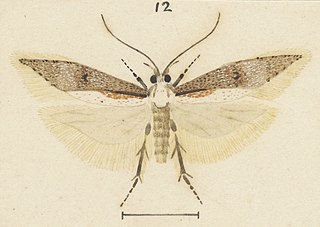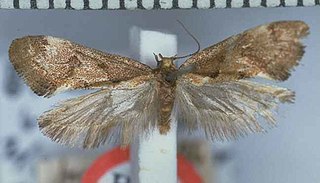
Plutella porrectella is a moth of the family Plutellidae found in Europe, the Caucasus, southern Siberia and Asia Minor.
Batrachedra plagiocentra is a species of moth of the family Batrachedridae. It is found in Australia.
Helcystogramma ineruditum is a moth in the family Gelechiidae. It was described by Edward Meyrick in 1926. It is found in Russia.
Garrha mitescens is a moth in the family Oecophoridae. It was described by Edward Meyrick in 1914. It is found in Australia, where it has been recorded from Queensland and the Northern Territory.
Garrha agglomerata is a moth in the family Oecophoridae. It was described by Edward Meyrick in 1920. It is found in Australia, where it has been recorded from South Australia.
Dichomeris attenta is a moth in the family Gelechiidae. It was described by Edward Meyrick in 1921. It is found in Zimbabwe.
Dichomeris excoriata is a moth in the family Gelechiidae. It was described by Edward Meyrick in 1913. It is found in Assam, India.
Hypatima microgramma is a moth in the family Gelechiidae. It was described by Edward Meyrick in 1920. It is found in Australia, where it has been recorded from New South Wales.
Schizovalva ebenostriga is a moth of the family Gelechiidae. It was described by Anthonie Johannes Theodorus Janse in 1960. It is found in South Africa.

Kiwaia heterospora is a moth in the family Gelechiidae. It was described by Edward Meyrick in 1924. It is found in New Zealand.
Chlamydastis synedra is a moth of the family Depressariidae. It is found in Paraguay.
Comocritis pindarica is a moth in the family Xyloryctidae. It was described by Edward Meyrick in 1924. It is found on New Guinea.
Coptotelia bipunctalis is a moth in the family Depressariidae. It was described by Warren in 1889. It is found in Brazil.
Gonionota comastis is a moth in the family Depressariidae. It was described by Edward Meyrick in 1909. It is found in Peru and Colombia.
Gonionota erotopis is a moth in the family Depressariidae. It was described by Edward Meyrick in 1926.
Hypercallia halobapta is a moth in the family Depressariidae. It was described by Edward Meyrick in 1930. It is found in Brazil.
Hypercallia argyropa is a moth in the family Depressariidae. It was described by Edward Meyrick in 1914. It is found in Peru.
Stenoma picrantis is a moth in the family Depressariidae. It was described by Edward Meyrick in 1930. It is found in Pará, Brazil.
Stenoma dryocosma is a moth in the family Depressariidae. It was described by Edward Meyrick in 1918. It is found in the Guianas and Brazil.

Tingena brachyacma is a species of moth in the family Oecophoridae. It is endemic to New Zealand and has been found in the south of the South Island. This species inhabits open swamps, native forest and scrubland and has been collected amongst Leptospermum. The adults of the species are on the wing in November and December.


